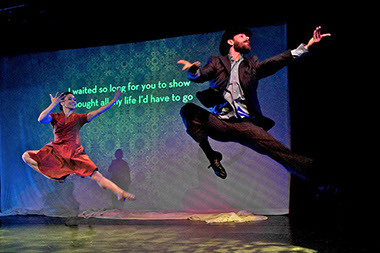
Janet Roston, Director/Choreographer, Cindy Shapiro Composer/Lyricist of Anaïs, A Dance Opera offer workshops in dance, theatrical movement, choreography, vocal training, music composition, collaborative creation and research techniques. Workshops tailored to all levels and ages. Many of these workshops can be open for large group community events.
DANCE TECHNIQUE, DANCE REPERTORY, STORYTELLING THROUGH MOVEMENT
Dance Technique
Contemporary dance for all levels
Repertory from “Anaïs, A Dance Opera”
Repertory could include: “Little Innocent Girl,” “Dream/Guernica,” “Train,” “To the Edge”
Basics of Dance Composition
Master class or extended residencies in elements of movement and choreography.
Movement composition derived from classic literature
Use of characters, plot, tone, setting and storyline to create movement studies.
Choreography from personal experience
Use of journals, dreams, blogs as a jumping off point to create compelling dance
Creating movement studies from the Cafe Culture of Paris, Artists
Using artists of the time and the art movement they represent; cubism, surrealism etc (Pablo Picasso, Salvadore Dali, Chagall) as inspiration for dance and theatrical movement studies.
Creating movement studies from the Cafe Culture of Paris, Literature
Using writers of the time (Ernest Hemmingway, F. Scott Fitzgerald, Henry Miller, Gertrude Stein) as a basis for movement studies. Using themes, vocabulary and visualization as well as specific scenes from literature for the development of movement studies.
MUSIC COMPOSITION AND VOCAL TECHNIQUE
Vocal technique
All levels — basic vocal technique, including pitch issues, vocal placement, smoothing out vocal registers, larynx control, and breathing
Songwriting
Starting with a premise and working our way through the composition of the song.
Theory Perspective
Musical discussion of pieces from the opera, lead sheets provided for the class for discussion purposes — “Cold Cold Night”, “Hugh”, “Delta of Venus”, “You See Me”, “Lie Box” Discussions of harmonic theory and rhythm theory around some of the more complex songs in the show.
NIN’S ROLE, COLLABORATIVE PROJECTS, RESEARCH TECHNIQUES
The history of Anaïs Nin — more in-depth than the show can go
An in-depth look at her life and work
Collaboration in Creating Work
The art of working with other artists
Research techniques
Preparing the bed of the narrative through careful research
Janet Roston, Educator, Dance and Movement for Theater
A master dance educator, for many years Janet was the Artistic Director of Beverly Hills High School’s acclaimed Dance Company whose members have gone on to form their own successful dance companies and become professional dancers, actors, musicians, graphic designers etc. She has taught dance and movement for actors internationally in London at Millennium Performing Arts Academy, London Studio Centre and Arts Educational as well as teaching in Toulouse and Cannes. National master dance/movement classes includes UCLA, Cal State Long Beach, CAHPERD, Atlanta’s Pebblebrook Arts Academy and Boston Conservatory. Janet has a BA and MA in Dance from UCLA and a California teaching credential in Physical Education, Dance, English and Elementary Education.
Cindy Shapiro, Educator, Music and Vocal Technique
Cindy’s journey to composing “Anaïs” has been varied. As such she her teaching background is diverse yet interrelated. As a music instructor she has taught music theory, vocal technique, music appreciation, songwriting and conducting. Currently she is a private vocal coach working with rank beginners with pitch issues to professionals who want to elevate their craft. She has been a video game coder applying this background to teach technology to students, including logic, set theory, coding and gaming applications. Cindy has a degree from Antioch University with a focus in Music Composition and a Kodaly Music Pedagogy Certification from Cal. State Univ. Long Beach.

